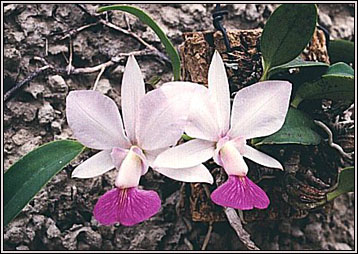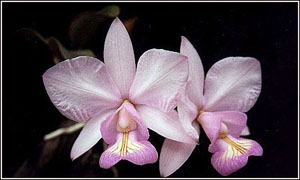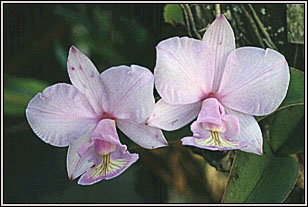Jayr
Fregona Júnior was born in the state of Espírito
Santo, one of the most rich or the most rich state of
Brazil in orchid species. He is plastic surgeon and orchidist.
He created and maintains the site Orkideas (http://www.orkideas.com.br)
besides a list of discussion with the same name. In his
homage, Lou Menezes described the natural hybrid between
Brassavola tuberculata and Cattleya guttata,
under the name of Brassocattleya fregoniana
|
ON: Jayr,
why did you start to cultivate orchids? Which
was the magic moment of attraction?
JF: My first contact with orchids happened in 1980, when a friend
of mine, Gilmar L. Pimentel, invited me to look for orchids
in the borders of Linhares lagoons. My father had a boat et
my friend needed one to make easy his stroll. Although we didn't
find any thing, he gave some plants which have been planted
on the trees in my ranch. They stayed there but I didn't show
any interest on them, not for that time.
In 1990, when I was at the college, another friend, Fernando
Gil, invited me to his home to see his father's coin collection
(also one of my hobby). We sit down on the balcony, in front
of the orchid greenhouse and his father asked me to look for
an orchid when went to the state of Bahia for fishing. He taught
me how an orchid was. Thus, in my next fishing trip, along the
Peruipe river, looking at every tree and seeing a thousand of
"orchids" (nowadays I know they were bromeliads not
orchids), I found something that should be an orchid which two
buds. When I got home, I thought: “The orchid flower is
said to be exotic, so I will see this flower before giving the
plant to Fernando”. I put the plant in a crotch of a tree
and looked at it every day waiting for the bud opening. After
15 days of anxious waiting, I said to my self: “It
should be really exotic because 15 days have passed and they
haven't opened yet”. The wait went on and nothing, 15
days more and the doubt arose: “May they open during the
night and close at the morning?”. Some nights, in different
times, I tried to get the plant of-guard but nothing, it stayed
unruffled, with two green bud without opening. So my interest
lost down until forgetting the plant there. One day, my father
who has never heard about orchids, told me: "Did you see
the plant you brought from Bahia? It is loosening seeds".
That was the moment the dummy's ears started to grow and the
orchidist flame lighted. In a hurry, I went to there and saw
a thin powder, I got it and went to the laboratory, look at
the microscopic and saw the nucleic seeds. Thus the thought
came again: "I will see how to sow this and instead of
giving Fernando juts one plant, I will give many”. This
very saturday I bought the book "O cultivo de Orquídeas
no Brasil" (Orchid cultivation in Brazil), by Waldemar
da Silva. At the end of the week, I have already read three
ice and in the Monday, I was able to seed.
The fungi were really a trouble and I was upset to notice that,
after trying 8 months, there was not germination or the fungi
came out. The rest of the seeds I threw on the tree fern had
germinated and the plants were 2cm long.
I gave the plant to my friend and started to get many other
from other orchidists, besides the demands to try to sow their
plants.
ON: Besides
this fact, was there any influence (people or fact) regarding
your relationship with orchids?
JF: I can also mention: Éledio Braz Dalmaschio, a great
friend who encouraged me a lot;
Wladyslaw
Zaslawski ,
great friend and master in every thing needed; Auceu Berger,
friend and professor about cultivation and genetic.
ON: How long have you been cultivating
orchids? ?
JF: At about 12 years.
ON: How many plants do you have?
JF: I have been reducing a lot the number of plants because
there is no time to take care of them. Although I have never
counted, I believe I have at about 2000 matured plants and the
same number between flasks and “seedlings”.
ON: How long do you spend taking care of your orchids daily?
JF: As I said, nowadays time is not enough, so I have someone
to take care of them but during the week-end I spend sometime
with them.
ON: Do
you prefer hybrids or species? Why?
JF: I prefer species because it is something limited. As a collector,
I believe we should have an aim and if we think that a species,
although far way, is something more defined than hybrids which
can be infinite.
ON:
Among
yours, do you have a favorite plant?
JF: There are many such Cattleya walkeriana semi alba
“Corpus Christi”; Laelia crispa estriata
“Baronesa”; Cattleya warneri semi alba
“Jayr Fregona”. |

Cattleya
walkeriana semi alba “Corpus Christi”
|
ON:
Which are the climate conditions in your place?
JF: Hot climate, at the sea level.

Cattleya
nobiolior amaliae |
|
ON: Do you have a cultivation tip to share
with us?
JF: The plants need fertilizer to stay alive inside the pots.
So be rigorous in the matter and you will have wonderful plants.
Concerning the sow, I will repeat the same thing Wladyslaw Zaslawski
told me when we first met: “Jayr, to sow is simple but
you should do right to get the right results, do not try to
improvise or change formula, the possibility of getting wrong
is bigger.”
ON:
Is there a short or an amusing story connected to orchids you
can tell us?
JF: There are many stories... Once I bought many plants of the
same salesman and he gave me an ordinary cross of the species.
Many times after the plant bloom and it was a wonderful C.
warneri semi alba, completely different from the other I've
seen. When I told him about, he said: "You are luck because
there is nothing good resulting from this cross, except for
this plant you're showing me. And, look, many of them have already
bloomed."
ON:
There is a natural hybrid from your state (Espírito Santo)
which pay homage to you. How did you find this plant?
JF: The natural hybrid between C. guttata x Brassavola tuberculata
has been described by L.C. Menezes as Brassocattleya fregoniana,
however some people believe that this hybrid is, in fact, the
same as Bc. Tramandahy - between C. tigrina (ex-leopoldii)
and Brassavola tuberculata, which has been described
before. Even I don't know what to think about because if we
consider C. guttata as a different species from C.
tigrina (ex-leopoldii), we should consider
that as a different hybrid. However if we consider that C.
guttata is the same species as C. tigrina (ex-leopoldii),
we will have only one hybrid but which one would be a valid
taxon? That which has been described first or which has been
described from the older species? Because if it is the same
species, C. tigrina (ex-leopoldii) doesn't exist
any more and everything will be considered as C. guttata
which is the older taxon described. So I don't know how
it should be considered but I let this questions to the botanists.
Concerning the story about this plant, in 1992, my friend Fernando
told that L.C. Menezes was looking for a plant which would be
a natural hybrid between Cattleya guttata e Brassavola
and we decided to look after it in order to send her. We strolled
around Vitória and didn't find anything. Many years ago,
I found the plant when I was walking with Elédio, we
got 3 cuttings and I send one to L. C. Menezes, who decided
to pay homage to me named it with my name. I've never count
on this but it happened.
|

Cattleya
nobiolior amaliae |
ON: One
said that orchidophilia a soft manifestation of madness. Have
you done any "orchidophilic" insanity?
JF: Yes, once I decided to visit an unknown habitat with 3 friends.
I would be a long trip, at about 400 km of paved road and 180
km without pavement. Everything was agreed, we would go in my
6.000km car to visit the habitat. I was just starting to drive.
All of them canceled the trip but I decided to go.
Everything was alright, I traveled tranquil the 400 km of paved
road listening to a good music. The second phase, things got
worst. At the 9 km , the car skidded, crushed against the steep
bank and turn upside down. Briefly, the car was considered as
total loss and I should stay in the next city waiting for the
next bus to come back home.
I tried to convince the cops to bring me there or to find a
car to rent but they didn't listen to me. So I got home without
visiting the habitat.
ON: Is there anything you want to add?
JF: : Yes, I would say that orchids are the pretence, they are
the great excuse to share and to meet friends.
In exhibitions, people are showed, not the plants. Have you
though that how many times you have heard or you have done the
question: “John Doe” didn't come or he didn't come
to this show” (nobody asks if "such-and-such"
plant comes). So, cultivate your friends more than your plants,
althought the plants are beloved, at the end, they bring friends.